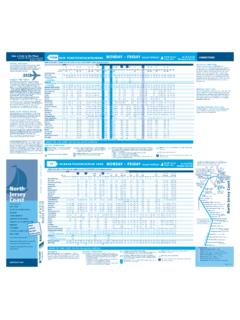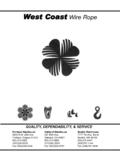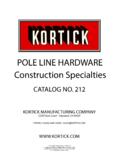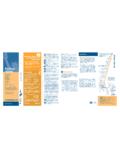Transcription of Boat Crew Seamanship Manual - Coast Guard Auxiliary Islip ...
1 Chapter 7 Marlinespike Seamanship Construction Strands are twisted to either the right or the left. This twisting is the lay of the line . line may have either a left lay or a right lay depending upon how the strands are twisted together. line is usually constructed as plain-laid, plaited, and double-braided lines. Figure 7-1. illustrates fiber rope components and construction. The type of construction will depend upon the intended use of the line . The following describes line types: line Type Characteristics Plain-laid Made of three strands, right- or left-laid. Most common is right- hand laid. Cable-laid Made of three, right-hand, plain-laid lines laid together to the left to make a larger cable. Plaited Made of eight strands, four right-twisted and four left-twisted. Strands are paired and worked like a four strand braid. Braided Usually made from three strands (sometimes four) braided together.
2 The more common braided lines are hollow-braided, stuffer-braided, solid-braided, and double-braided. Double-braided Made of two hollow-braided ropes, one inside the other. The core is made of large single yarns in a slack braid. The cover is also made of large single yarns but in a tight braid that compresses and holds the core. This line is manufactured only from synthetics, and about 50% of the strength is in the core. 7-4. Chapter 7 Marlinespike Seamanship Natural Fiber line Composition Natural fiber line is made from organic material, specifically, plant fiber. The following describes the various natural fiber lines: Natural Fiber line Type Characteristics Manila Made from fibers of the abaca plant and is the strongest and most expensive of the natural fibers. Sisal Made from the agave plant and is next in strength to manila, being rated at 80% of manila's strength. Hemp Made from the fiber of the stalk of the hemp plant, is now rarely used.
3 Cotton Made from natural fibers of the cotton plant, may be three-stranded, right-lay or of braided construction used for fancy work and lashings. Uses of Natural fiber line , usually manila, hemp or sisal, are used for tying off fenders, securing Natural Fiber line chafing gear, and doing other small projects where line strength is not a major concern. Braided line is most commonly used for signal halyard, heaving lines, and lead lines. Plain-laid line may be used for securing loose gear, fender lines, and fancy work. CAUTION ! Do not use natural fiber line as a towline. Limitations Natural fiber line has a lower breaking strength than synthetic fiber line of an equal size, and unlike synthetic line , natural fiber line does not recover after being stretched (elasticity). In the Coast Guard , it is not used for load-bearing purposes on boats. Another limitation of natural fiber line is the likelihood of rotting if stowed wet.
4 Construction A close look at a natural fiber line will reveal that the strands are twisted together. They will have either a right or left lay. Plain-Laid Plain-laid line is the most common type of natural fiber line used in the Coast Guard . In Lines plain-laid, three strands are twisted together to the right in an alternating pattern. Because of the number of strands, this line is sometimes called three-strand line . The yarns making up the strands are laid in the opposite direction of the strands. These are twisted together in the opposite direction to make the line . The direction of the twist determines the lay of the line . In the case of plain-laid lines, the yarns are twisted to the right. They are then twisted together to the left to make the strands. The strands are twisted together to the right to make the line . (see Figure 7-1). 7-6. Chapter 7 Marlinespike Seamanship Synthetic Fiber line Composition Synthetic fiber line is made of inorganic (man-made) materials.
5 The characteristics of synthetic fiber line are considerably different from natural fiber line . The differences will vary depending on the type of material from which the line is made. The following identifies the various types of synthetic fiber line used: Type Characteristics Nylon A synthetic fiber of great strength, elasticity, and resistance to weather. It comes in twisted, braided, and plaited construction, and can be used for almost any purpose where its slippery surface and elasticity is not a disadvantage. Dacron A synthetic fiber of about 80% of the strength of nylon that will only stretch 10% of its original length. Polyethylene and A synthetic fiber with about half the strength of nylon, 25% lighter Polypropylene than nylon making it easier to handle, and it floats in water. Commonly The most common types of synthetic line used on Coast Guard boats are nylon and Used Types polypropylene.
6 Because of its superior strength and elasticity, nylon is used where the line must bear a load. Double- Double-braided nylon line is the only line used for towlines on Coast Guard boats. Braided Nylon line However, privately owned Auxiliary facilities might have towlines other than double- braided construction. When double-braided line is made, the yarns are woven together much like the individual yarns in a piece of cloth are woven. The actual line consists of two hollow braid lines, an inner core and an outer cover. The core is woven into a slack, limp braid from large single yarns. The cover is woven from even larger yarns into a tight braid to cover and compress the core. Advantages Double-braided nylon has two other characteristics that increase its strength, elongation and elasticity. Elongation refers to the stretch of the line and elasticity refers to the ability of the line to recover from elongation.
7 Synthetic line will stretch farther and recover better than natural line . Because of this, synthetic line can absorb the intermittent forces and surges resulting from waves or seas much better than natural fiber line . Limitations While its superior strength makes double-braided nylon line the preferred choice for load bearing, there are disadvantages. Because it will stretch further (elongate) and still recover (elasticity), the snap back potential if the line parts is greater than with natural fiber line . Also, if nylon line is doubled and placed under excessive strain, there is a danger that the deck fittings might fail. If that happens, the line will snap back like a rubber band, bringing the deck fitting with it. Additionally, damage to the engine or deck fittings could occur if the bollard pull is exceeded. Never double a line or use a single line that can withstand more pulling force than the bollard pull of CAUTION !
8 The towing bitt. Bollard Bollard pull is the point where the static pulling force becomes such that any increase in Pull engine load could lead to damage to the engine or the towing bitt. 7-7. Chapter 7 Marlinespike Seamanship Plain-Laid Orange-colored polypropylene line is used on Coast Guard boats for life rings and heaving Polypropylene line lines. Advantages The advantages to this line are high visibility and flotation. Limitations The main disadvantage of plain-laid polypropylene line is lack of strength compared to nylon line of equal size. Its loose, course weave makes it easy to splice but susceptible to chafing. Aggravating this is polypropylene's characteristic of deteriorating rapidly when exposed to continuous sunlight. It can, in fact, lose up to 40% of its strength over three months of exposure. For this reason, the line is best kept covered when not in use, and inspected and replaced on a regular basis.
9 Slippage Synthetic line slips much easier than natural line . Because of this, it will slip through deck fittings and will not hold knots as well. Care should be taken when bending synthetic line to an object or to another line to ensure the knot will not slip out. One way to help prevent this is to leave a longer tail on the running or bitter end than with natural fiber line . To minimize the hazard of being pulled into a deck fitting when a line suddenly surges, ensure all CAUTION ! crewmembers stand as far as possible from the equipment. Work the lines with hands at a safe distance from the fittings. This is particularly important during towing operations. When using synthetic lines consider the following: Considerations Synthetic line will slip more easily than natural fiber line . Use caution when paying it or surging it from deck fittings. Beware of slippage when bending synthetic line together or securing.
10 Never stand in a position where exposed to the dangers of snap back if the line parts. Do not double up the line during a towing operation. Keep working surfaces of bitts free of paint and rust. Do not stand in the bight of a line or directly in line with its direction of pull. Cutting The use of a hot knife is the preferred method for cutting nylon and polypropylene line . Using a hot knife eliminates the need for burning the ends. Commercial electric knives, used by sail makers, are available. Some soldering irons can be fit with blades for cutting line . One of the more common methods is to heat an old knife or scraper using a propane torch. When cutting the line , the blade or saw should not be forced through the line , as the heat will do the job The best method is to work from the outside in. First, an incision is made around the circumference of the line , and then a cut is made through the center.






